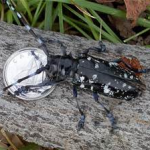As if Indiana homeowners, businesses and municipalities haven’t had enough to worry about in their landscapes since the Emerald Ash Borer (EAB) invasion started several years ago, there is now another insect threat that is approaching. It is known as the Asian Long-horned beetle (ALB). Like the EAB, they attack trees but this critter prefers maple species, including boxelder, Norway, red, silver, and sugar maples. They are also known to attack birches, Ohio buckeye, elms, horse chestnut, and willows. According to the U.S Forest Service, a complete list of host trees has not yet been determined. It does take much imagination to realize this insect is a substantial threat to Indiana’s tree population. Combined with the damage from the EAB, Indiana could lose as much as 75% of its street trees and a substantial portion of its forests. The spread of both pests is a result of the movement of infected firewood. While the ALB has not yet been reported in Indiana, it has been found in the Chicago and Cincinnati areas. The key to containing its spread is early detection. Therefore, the U.S Department of Agriculture, Animal, and Plant Health Inspection Service is asking people to take time to examine trees on their property for these pests. August appears to be a prime time to do this. Reporting infestations can be done with a smartphone, computer or a phone call. In Indiana, the phone number is 1-866-NO-EXOTIC or a few clicks on the free Great Lakes Early Detection Network smartphone app. Purdue has a YouTube video to demonstrate the ease of using the app to alert authorities.
Now all you need to know are the signs of ALB infestation. Your inspection should focus on the tree trunk and branches; the leaves will often appear normal. There will be perfectly round holes the size of a dime with fine piles of sawdust shaving coming out of the holes or in piles on branches or the base of the tree. Also, you may notice dark pockmarks on the trunk or branches accompanied by wet and bleeding sap. The ALB is easy to recognize as a shiny black beetle with white spots and black and white antenna that are longer than the insect’s body. The beetle itself measures about 1-1 1/2 inches long.
The difference in damage caused by the EAB is distinct from the ALB. The EAB attacks ash trees and those tree will have dead and dying branches near the top of the tree. Other clues are woodpecker holes, vertical splits in the bark and D-shaped exit holes. During late summer, symptoms become more apparent when infested trees are too stressed to maintain a fully leafed canopy.
While the EAB has been difficult to control in Indiana, concerned citizens can help stop the spread of the ALB by reporting any infestations. Because of their efforts, the ALB has been contained oreradicated in four different states. It is vital to have public involvement to help protect the trees of Indiana.